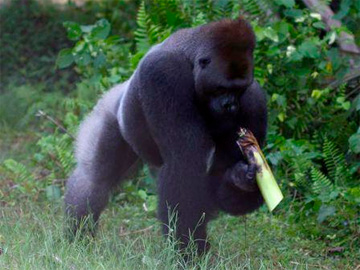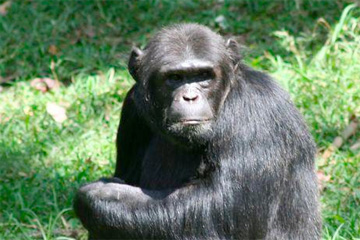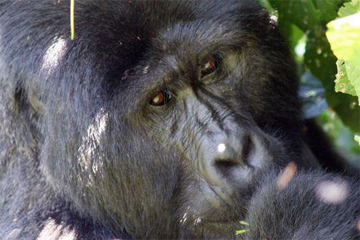Most people wish each day had more than 24 hours. But as the planet heats up, that limited number of hours might push endangered African apes even closer to extinction by making their current habitats unsuitable for their lifestyle, according to a controversial study published on 23 July in the Journal of Biogeography.
Researchers from the United Kingdom modeled how the most dire forecasts of climate change would affect the African habitats of gorillas and chimpanzees. They didn’t include the impacts of human encroachment or the burgeoning bushmeat market. But they did add a novel component: the ecology of the animals themselves. The scientists considered ape behaviors and body mass, as well as group size, a critical part of life for social animals.
 Lowland gorilla in Gabon. Photo by Rhett Butler |
“This approach is strongly rooted in the actual biology of the species under consideration,” commented Erik Willems, a postdoctoral researcher at the University of Zurich’s Anthropological Institute and Museum, in an email to mongabay.com. Willems was not part of the study.
Scientists compiled behavioral data from 20 African ape populations and used mathematical equations containing climatic variables to describe the apes’ activities. Then, using a ‘worst-case’ scenario for climate change by the year 2100, they plugged in a 5.2 degree Celsius temperature increase based on projections made in 2007 by the Intergovernmental Panel on Climate Change, and a 15% increase in rainfall based on a model by researchers from Remote Sensing Systems.
The results were grim: in 90 years, current gorilla habitats could shrivel by as much as 75 percent. Chimpanzees could lose 50 percent of their habitats.
The reason? To avoid overheating, the animals would need to spend more time resting, leaving less time to forage, eat, and socialize. Simply put, apes would need more than 24 hours in a day to survive in all but the most hospitable locations.
 Chimpanzee in Uganda |
“Inactive time is needed for digestion, predator avoidance and thermoregulation,” co-author Amanda Korstjens, of Bournemouth University, told mongabay.com in an email.
Losing time for social interactions would fragment the social groups, lead author Julia Lehmann of Roehampton University told mongabay.com in an email. Smaller groups leave apes vulnerable to predators and limit safe spaces. If suitable habitats decline and become farther apart, ape survival would be increasingly constrained by natural resources and the physical demands of coping with the heat.
Lehmann suggested conservationists could use the study’s predictions to inform their efforts.
“Our type of model can show where relatively safe havens are, where groups can live in large enough sizes,” Lehmann said. “We need to ensure that conservation areas are large enough to allow apes to maintain their social group structure.”
While the study’s approach is novel, researchers should regard its predictions cautiously, commented quantitative ecologist Peter Walsh of Vaccinape, an international consortium dedicated to ape conservation, in an email to mongabay.com.
 Lowland gorilla in Gabon. Photo by Rhett Butler |
“This is an interesting first stab at a serious issue,” Walsh said. “However, it comes with a very high level of uncertainty, from the model relating climate variables to ape population viability, to the data used to parameterize the model, to the assumptions about future climate change. The value of this paper lies as a catalyst for further research rather than in the predictions it makes.”
Lehman agreed, noting that human pressures on great apes outstrip the stresses of a warming climate. “I would assume that the ape’s future is probably bleaker than predicted by our model,” she said.
Citation: Lehmann J, Korstjens AH, and Dunbar RIM. Apes in a changing world – the effects of global warming on the behaviour and distribution of African apes. Journal of Biogeography, 23 July 2010
Nadia Drake is a graduate student in the Science Communication Program at the University of California, Santa Cruz.
Related articles